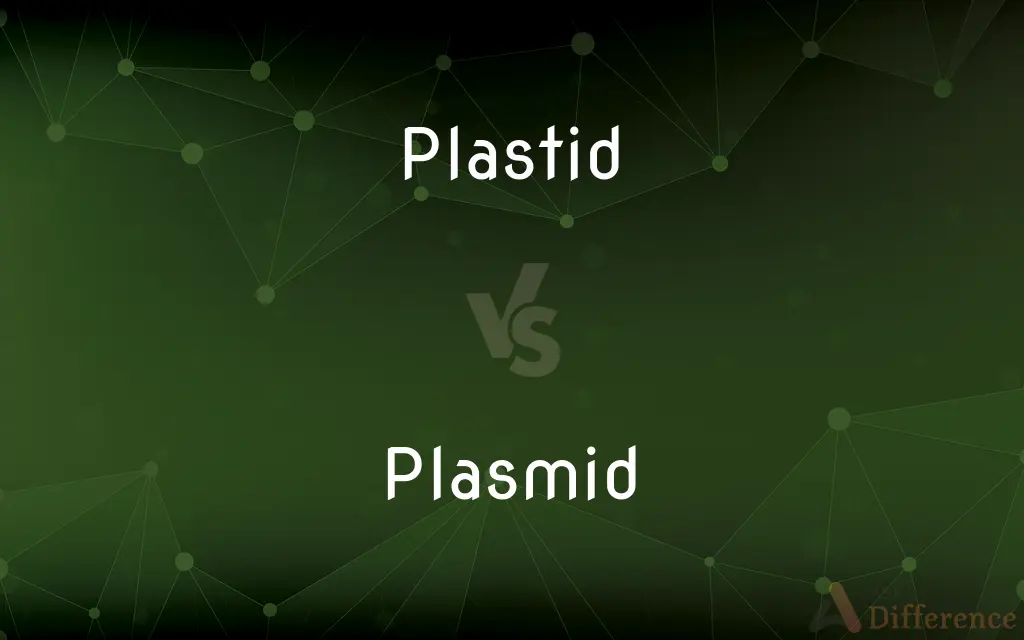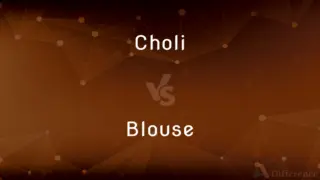Plastid vs. Plasmid — What's the Difference?

Difference Between Plastid and Plasmid
ADVERTISEMENT
Compare with Definitions
Plastid
The plastid (Greek: πλαστός; plastós: formed, molded – plural plastids) is a membrane-bound organelle found in the cells of plants, algae, and some other eukaryotic organisms. They are considered to be intracellular endosymbiotic Cyanobacteria.
Plasmid
A plasmid is a small, extrachromosomal DNA molecule within a cell that is physically separated from chromosomal DNA and can replicate independently. They are most commonly found as small circular, double-stranded DNA molecules in bacteria; however, plasmids are sometimes present in archaea and eukaryotic organisms.
Plastid
Any of several cytoplasmic organelles, such as chloroplasts, that contain genetic material, have a double membrane, and are often pigmented. Plastids are found in plants, algae, and certain other eukaryotic organisms and have various physiological functions, such as the synthesis and storage of food.
Plasmid
A circular, double-stranded unit of DNA that replicates within a cell independently of the chromosomal DNA. Plasmids are most often found in bacteria and are used in recombinant DNA research to transfer genes between cells.
Plastid
(cytology) Any of various organelles found in the cells of plants and algae, often concerned with photosynthesis
ADVERTISEMENT
Plasmid
(cytology) A loop of double-stranded DNA that is separate from and replicates independently of the chromosomes, most commonly found in bacteria, but also in archaeans and eukaryotic cells, and used in genetic engineering as a vector for gene transfer.
Plastid
A formative particle of albuminous matter; a monad; a cytode. See the Note under Morphon.
Plasmid
A piece of DNA, usually circular, functioning as part of the genetic material of a cell, not integrated with the chromosome and replicating independently of the chromosome, but transferred, like the chromosome, to subsequent generations of daughter cells. In bacteria, plasmids often carry the genes for antibiotic resistance; they are exploited in genetic engineering as the vehicles for introduction of extraneous DNA into cells, to alter the genetic makeup of the cell. The cells thus altered may produce desirable proteins which are extracted and used; in the case of genetically altered plant cells, the altered cells may grow into complete plants with changed properties, as for example, increased resistance to disease.
Plastid
Any of several types of minute granules found in the protoplasm of vegetable cells, having their own membrane, robosomes, and DNA. Among plant cells the most common are chloroplasts, which contain the chlorophyll and the photosynthetic machinery of the cell. They are divided by their colors into three classes, chloroplastids, chromoplastids, and leucoplastids.
Plasmid
A small cellular inclusion consisting of a ring of DNA that is not in a chromosome but is capable of autonomous replication
Plastid
Any of various small particles in the cytoplasm of the cells of plants and some animals containing pigments or starch or oil or protein
Share Your Discovery

Previous Comparison
Choli vs. Blouse
Next Comparison
Skinwalker vs. Shapeshifter













































